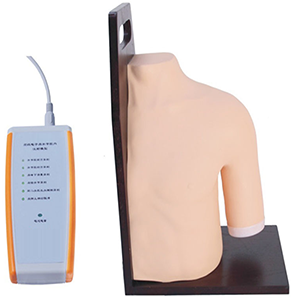

Article tag: Intracavitary Shoulder Injection Model| BIX-CK20133| Medical Teaching model|
According to relevant studies, students who use simulation models to train are generally better than those who use traditional teaching methods in terms of operational proficiency and self-confidence. The data show that the operation success rate of the trainees who have been trained by the model is about 30% higher than that of the trainees who have not ...
Intracavitary injection of shoulder joint is a highly technical operation, which involves the complex anatomical structure of shoulder and important blood vessels and nerves. It is vital for medical students and clinicians to get this technique right. However, traditional teaching methods often rely on live cases and clinical practice, and such training is not only risky, but also limited by the actual number of cases. With the advancement of medical simulation technology, can the intra - injection model of shoulder joint, as a new training tool, provide a safer and more effective training environment for medical education?
1. Simulation environment: Provide students with risk-free practice opportunities

Intracavitary Shoulder Injection Model
One of the greatest advantages of the shoulder intra - cavity injection model is its ability to provide a risk-free simulation environment. In traditional teaching, students usually rely on actual cases to operate, and in the process of operation, once there is a mistake, it may lead to serious complications, such as blood vessel damage, nerve damage or infection. By using a highly simulated intracavity injection model of the shoulder joint, students can practice repeatedly in a simulated environment, not only mastering the operation skills, but also familiarizing themselves with the anatomy of the shoulder joint and the key injection sites. This risk-free training approach significantly reduces the incidence of errors in clinical practice.
Data support:
Studies have shown that doctors trained using simulated models have significantly improved operational success in real-world clinical Settings. Through repeated practice, students are able to deepen their understanding of shoulder anatomy, reducing the chance of accidental injury to important structures such as nerves and blood vessels.
2, reduce clinical risk: accurate operation to reduce accidental injury
Intramural injection of shoulder joint involves precise positioning of shoulder joint cavity, improper operation may lead to serious consequences. A missed shoulder injection can lead to joint damage, broken blood vessels or nerve damage, and these complications can have a long-term impact on a patient's health. Through the training of the shoulder cavity injection model, students can accurately grasp the entry Angle, depth and required force of the needle, so as to avoid mistakes in real operation.
Data support:
After using simulation training, the error rate of medical personnel in the clinic was reduced by about 40%. This proves that simulation training can effectively improve the accuracy of operation and avoid medical errors caused by inexperience.
3. Improve learning efficiency: Accelerate skill mastery and application
Traditional medical training often relies on the practice of real cases, but the number of real cases is limited, and the progress of training is slow, especially in technically demanding operations, and often takes a long time to achieve proficiency. The intracavity injection model of shoulder joint can provide more practice opportunities, and students can perform repeated operations according to their own learning progress in the simulated environment, and gradually master complex skills. Simulation training can not only help students master the technology faster, but also improve the overall efficiency of learning.
Data support:
According to relevant studies, students who use simulation models to train are generally better than those who use traditional teaching methods in terms of operational proficiency and self-confidence. The data show that the operation success rate of the trainees who have been trained by the model is about 30% higher than that of the trainees who have not been trained by the simulation.